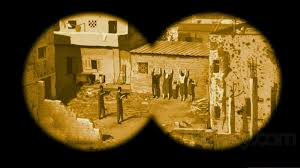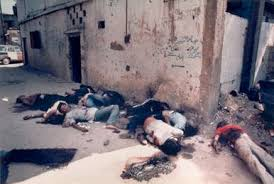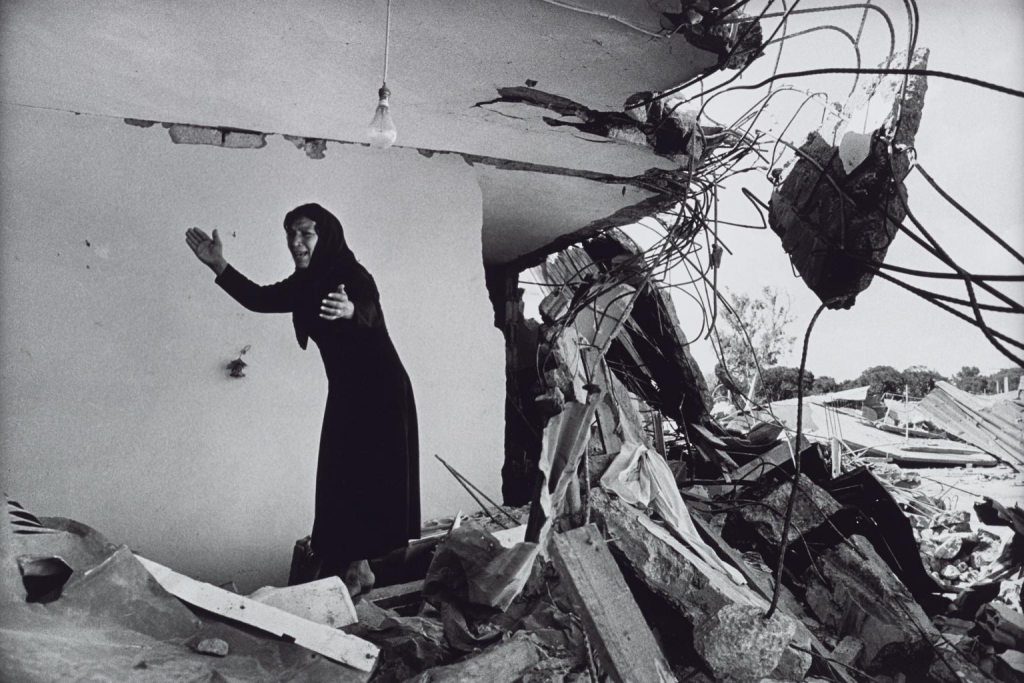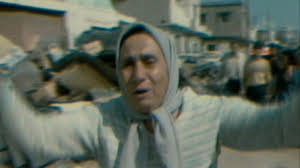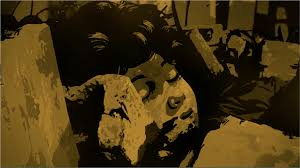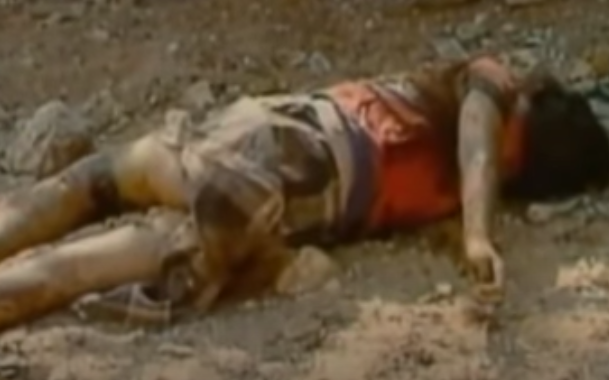Anonymous soldier: What to do? What to do? Why don’t you tell us what to do?
Ari Folman: Shoot.
Anonymous soldier: On who?
Ari Folman: How should I know on who? Just shoot.
Anonymous soldier: Isn’t it better to pray?
Ari Folman: Pray and shoot. [1]
In 2008 a new style of documentary filmmaking was released upon the Western world in an attempt to make some noise regarding the victims of the 1982 Lebanese war. Waltz with Bashir walks the viewer through a first-hand narrated war memoir of soldier and director of the film Ari Folman. The film juxtaposes animation with war-torn streets, explosions from RPGs and massacres of civilians, but it is Folman’s portrayal of dogs in the film that is fascinating. Following a dream about twenty- six dogs from a Beirut village, Folman explores deep into his psyche to discover that these animals represent much more than another pointless kill, he realises that they symbolise a nation that was silenced by the very people he was working for.
Folman served with the Israel Defence Force for twenty-two years when he decided at the age of forty that he had had enough and asked to leave. The IDF agreed ‘so long as you go to the army therapist and talk about everything you went through’.[2] Folman was nineteen when he was drafted to Beirut in 1982 and through the form of animation, he tries to make sense of his recollections of his war experiences. Even though the film is solidly rooted as a documentary, the interviews being the real voices of Folman’s friends from his past and present, it plays out as a cathartic confession about his involvement in the Lebanon civil war. When questioned for the Culture Section in The Guardian; Folman was asked why he chose animation to portray such a serious topic, Folman explained ‘There was no other way to do it, to show memories, hallucinations, dreams. War is like a really bad acid trip, and this was the only way to show that’.[3] Images from dreams such as the giant naked woman that emerges from the water and rescues his friend from a warship, would not have been possible without animation. The genre opened Folman up to portray his emotions and subconscious creatively.
With the barrier of linear narration removed, Folman opens the film with what the audience soon finds out to be, a dream sequence of a veteran friend Boaz Rein Buskila. Buskila makes contact with Folman regarding a recurring dream that he is having, hoping that his friend could offer some insight as to what the dreams could mean. Buskila’s dream always starts with a pack of dogs running down a Tel Aviv street. The dogs look rabid, saliva dripping from their bared teeth, their eyes wide and the frame is capturing their gaze straight on as they stare out to meet the audience’s gaze. The eyes and the teeth of the dogs are the most prominent feature, the same colour as the sky, a golden yellow colour that contrasts against the metallic greys and silvers reminiscent of war artillery, set against dusty streets. The dogs snarl at strangers in the street but dismiss them as it is not them that they are searching for. They knock over tables and chairs in the race to get to their enemy. Images of civilian life flashes past, mother in hand with her child on a school crossing sign are run across by these savages, a glimpse of a world the viewers recognise in their day to day life flies through the shot. Finally, the dogs reach their destination – outside the home of Buskila. They surround his window barking as he looks down on them. The opening sequence of the film only lasts just over two minutes but it acts as an important skeleton that the conscience of the film hangs upon. Buskila explains to his friend that he is specifically able to remember how many dogs are waiting for him at the window because of an Israeli military operation that he took part in when they served together. The army would stealthily move into a village and the dogs were used by the opposition to warn the men of an impending attack. Buskila was given the job to shoot every dog so they did not wake up the town and alert the men to their position. He recalls counting each dog (twenty-six) as he ended their lives for what was expressed to him at the time – a higher purpose. Whilst he explains this, the two friends speak in Hebrew to each other, their mother tongue, subtitled in English for the Western viewer.
The animals in this sequence not only act as nightmarish karma in which the dogs take revenge for their unprovoked death, but they also symbolise the non- combatants and the role that the Israeli soldiers played in the war. Buskila’s response to trauma in the aftermath of the war in the form of dreams raises questions retrospectively in his conscience as to whether they believed they were fighting on the right side of the war. The central symbolism of the dogs coming back to haunt the ex-soldier in his dreams is their representation of the Palestinians that were executed at mass by Phalangists. The Christian Phalangists (who were allied with the Israeli Defence Force) killed up to 3,500 Lebanese and Palestinian Shiite civilians in the Shatila refugee camp and the Sabra neighbourhood of Beirut, whilst the Israeli army stood by and witnessed it. This historic event makes up the last ten minutes of the film and is shown in real footage, revealing the aftermath of the Sabra and Shatila massacres. In his interviews with Folman, Buskila explains that because he was a young soldier he was not trusted to kill human enemies with his sniper, so the only way he could contribute was to shoot the dogs, but like Folman, all of the other memories have been repressed and the dreams are the only access to his younger self. Through Buskila’s recollection of the canine dream, Folman begins to remember moments from his past that the trauma had suppressed. Through the power of his subconscious, he had manipulated his memory into believing that the war that he had a part in was nothing noteworthy, just a job that needed to be done, but with the introduction of the animals, Folman starts to look at himself differently. He now sees himself and his fellow soldiers as the savage dogs, hunting the supposed enemy, and starts to question why he did not make this connection before. He starts to realise that it is the veterans that are savages.
When he starts to recall memories of the mass shootings, he starts to associate those feelings of guilt instead of the helplessness of reporting the murders to higher officers only to be ignored. He battles between being a victim of the greater scheme, a cog in the war machine and an individual who knew that his role would ruin the lives of others even if he was not aware of the full extent. His loyalty to the war effort mirrors the loyalty of the dogs protecting their territory but ultimately both paying for the consequences. In the interview with Folman, he explains that he wanted to make the last five minutes of the film real footage from the massacre to show the victims as real and three dimensional which when having watched the rest of the film in constant animation does stand apart. In doing this I believe he solidifies his comparison of the Palestinians and the dogs. Although the audience does get to see the women’s reaction to the devastation, they are not given a voice. A Western audience can only hear their cries of pain in a language they do not recognise, as they look around at their homes that have been destroyed and their children that have been killed. The audience is not privileged to have the women’s pain reaffirmed by subtitles as they have been with the soldiers. They are foreign. Other. They are not regarded as important enough to make sure that they are understood. The dogs cannot speak out in regards to the injustice that has been inflicted upon them, they can only be manipulated into a narrative to show their oppressor’s humanity. Like the dogs, the Palestinians needed to be silenced. Like the dogs, the Palestinians’ cries haunt their dreams.
Showcasing Waltz with Bashir for a western audience with assumed limited knowledge of the First Lebanese War, Folman does manage to create an inventive piece that sets itself apart from other documentaries on the subject, such as About a War (Abi Weaver, Daniele Rugo, 2018). Folman puts forward an animated war testimony that portrays the psychology of a soldier’s psyche through fluid artistic design. The portrayal of animals in this film act as a vehicle for the soldiers to perform a cathartic cleansing in which they can make peace with their actions. The animals also serve as a warning of revenge for their unnecessary deaths. Moreover, the genre brings life to subjects that would usually be represented via standard documentary modes and brings forward humanizing elements through representation via animation. The film ultimately asks the audience the question – who are the real victims of war?
[1] Bob – Waltz with Bashir, FilmFour 29 February 2016 02:15 https://learningonscreen.ac.uk/ondemand/index.php/prog/01176E99?bcast=121154025 (Accessed 28 May 2020)
[2] Lest we forget, The Guardian, https://www.theguardian.com/film/2008/oct/25/waltz-with-bashir-ari-folman [accessed 29/05/2020]
[3] Lest we forget, The Guardian, https://www.theguardian.com/film/2008/oct/25/waltz-with-bashir-ari-folman [accessed 29/05/2020]
Further Reading:
Films:
About a War (2018) dir. Abi Weaver, Daniele Rugo – another feature-length documentary from the POV of the soldiers
Video:
DP/30: The Oral History Of Hollywood, David Poland – Waltz With Bashir, writer/director Ari Folman, Online video, You Tube 3 May 2012
https://www.youtube.com/watch?v=eX9HdTr0OEY&t=258s – An interview with Ari Folman discussing his reaction to the reception of the film.
Books:
Bond, Lucy, Craps, Steph, Trauma: The new Critical Idiom, New York: Routledge, 2020 – A critical analysis of how Western society deals with trauma. It has some interesting points on PTSD and references the film in regards to how the soldiers recount their past trauma.
Bibliography
Bob – Waltz with Bashir, FilmFour 29 February 2016 02:15 https://learningonscreen.ac.uk/ondemand/index.php/prog/01176E99?bcast=121154025 (Accessed 28 May 2020)
Lest we forget, The Guardian, https://www.theguardian.com/film/2008/oct/25/waltz-with-bashir-ari-folman [accessed 29/05/2020]
A Palestinian Mother in Her Destroyed House, Sabra Camp, Tate, https://www.tate.org.uk/art/artworks/mccullin-a-palestinian-mother-in-her-destroyed-house-sabra-camp-ar01218



